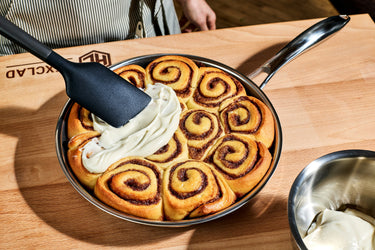5 Tips for the Best Cinnamon Rolls

What if we told you that the softest, pillowiest (yep, we’re making that a word) cinnamon rolls could come together with minimal effort and bake up beautifully in your 12"/25cm Hybrid Fry Pan? Well, it's a fact.
Our Skillet Cinnamon Rolls rival those at your favorite bakery, and they’re shockingly low-lift. The secret is in the enriched dough and a clever addition of half-and-half drizzled over top before baking, which locks in moisture and makes for deeply golden, caramelized edges. The filling is heady with cinnamon, of course, and gets a lift from a hit of orange zest that takes the sugary swirl somewhere divine. Thick swooshes of fluffy cream cheese frosting are the final flourish. No stand mixer, no specialty tools, just your trusty skillet and a weekend baking plan.
We chatted with Leah Koenig, IACP Award-winning cookbook author and writer of The Jewish Table newsletter, for her top tips to help you nail this recipe like a pro.
1. Yeast Mode
Cinnamon rolls are made with enriched dough, which includes butter, sugar, oil and/or eggs. A standard dough, on the other hand, is made of only water, flour, salt and yeast. Normally, those recipes will call for blooming the yeast in warm milk (or half-and-half, in our case). However, Leah finds that yeast doesn’t bloom quite the same way in milk products, and it can be hard to see. Instead, she offers a clever workaround: You’ll start by blooming the yeast in water and add the half-and-half to the dough later.
Though working with yeast for the first time can be intimidating, Leah’s tips can help you succeed. “It does take a couple times to know what yeast is supposed to look like and smell like, and how it’s supposed to act,” she says. Adding yeast to warm water—around 110º F or so—allows it to bloom. This is the process of activating it.
“You want it to literally bloom,” Leah says. “It takes a few minutes, but you’ll notice it starts to bubble and sort of looks like the foam on a beer. If it doesn’t happen, start over, because this is the one point where you can make or break your dough.”
Of course, starting over isn’t ideal, but since this step comes right at the beginning, she points out, you aren’t losing too much progress. (Your yeast might not be blooming because you have a dead yeast packet or it’s expired.) As for getting the right temperature of water, you can use an instant-read thermometer, or follow Leah’s simple approach:
“I like to run the hot water from my tap and stick my wrist under it—don’t do this if your tap water gets scalding—but you basically want it where it’s uncomfortable but not burning you.”

2. Enrichment Program
In the case of our cinnamon roll dough, enrichment comes in two varieties: milk mixed into the initial mixture and butter kneaded into the dough.
“Butter’s fat content adds nice textural qualities,” Leah says. To slowly incorporate the butter, you’ll add a few pieces at a time, kneading until it’s incorporated. Kneading is a finicky business, but it's easy to get the hang of with an online video tutorial. “Push it with the heel of your hand, rotate it and pull it back,” Leah says.
If the dough seems greasy, fear not. “There can be times where the dough feels oversaturated with butter, and you might think it won’t turn into a supple dough,” she points out. But don’t give up just yet.
“Keep sprinkling additional flour as you knead and it will turn out. It probably will take five or six minutes before you get past that zone where it feels like a greasy mess. If you do it with a stand mixer [fitted] with a dough hook, you don’t really notice the greasiness as much.”
3. The Half-and-Half Hack
“People are always looking for ways to make yeasted dough moist,” says Leah. “You can enrich it with certain things...and painting it with a sugar syrup afterwards can also help. But pouring a little half-and-half over the buns before you cook them incorporates moisture from the buns as you bake and keeps them tender.”
It’s not just about getting the dreamiest texture ever, she points out. “The added benefit is that you get a bit of caramelization at the bottom.”
4. Freeze, Please
Making the rolls in your skillet means that you might not want to send it to the deep freeze, lest you need our kitchen workhorse for other recipes. That said, you could bake the rolls fully in the skillet, then pop them out after baking and freeze them. Reheat in a 350ºF oven until hot to serve, then top with the frosting.

5. Filling Station
While the cinnamon filling in these rolls is a classic for a reason, Leah suggests experimenting once you’ve tried the basic version. “You could add chopped walnuts or play with the spices. Add a bit of cardamom (not too much because of its strong flavor, maybe ¼ teaspoon) and a little cocoa powder to make a more babka-y chocolate-cinnamon thing. You could also play around with the cream cheese frosting and add a little orange blossom water or lime zest.”
Spiraling never tasted so good. Get the recipe!





